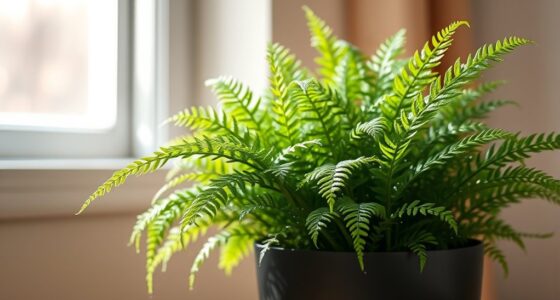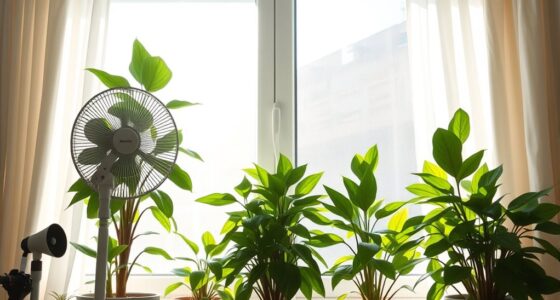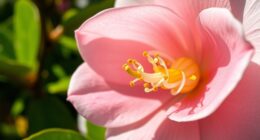To keep your cats and dogs safe, choose pet-friendly houseplants that are non-toxic and unlikely to cause health issues if nibbled. Popular options include spider plants, Boston ferns, and areca palms, which add beauty without risking your pet’s well-being. Regularly inspecting and maintaining plants help prevent accidents, and placing risky plants out of reach is wise. Keep your space both stylish and secure — your pets’ safety depends on it, and there’s more to learn to guarantee a happy home.
Key Takeaways
- Choose non-toxic houseplants verified by reputable sources to ensure safety for both cats and dogs.
- Opt for plants with sturdy leaves and stems that pets are less likely to chew or ingest.
- Regularly inspect and maintain healthy plants to reduce risks of pests or mold that could harm pets.
- Keep toxic plants out of reach or in elevated areas to prevent accidental ingestion.
- Provide alternative toys and safe zones to redirect pet attention away from houseplants.

If you have pets at home, choosing the right plants is essential to keep them safe and healthy. Knowing the difference between toxic vs non-toxic plants can make all the difference in creating a pet-friendly environment. Many popular houseplants are toxic to cats and dogs, causing symptoms ranging from mild irritation to severe health issues. On the other hand, non-toxic plants pose no threat and can brighten your space without risking your pets’ well-being. To ensure your furry friends stay safe, it’s vital to familiarize yourself with which plants fall into each category and implement proper plant care tips to maintain their health and safety.
Choosing safe plants for pets is key to a happy, healthy home environment.
Toxic vs non-toxic is a fundamental distinction when selecting houseplants. Toxic plants contain compounds that can poison pets if ingested, leading to symptoms such as vomiting, diarrhea, drooling, or even more serious conditions like difficulty breathing or organ damage. Non-toxic plants, however, are safe even if your pet chews or nibbles on them. When choosing plants, always verify their safety status through reputable sources, and keep in mind that even non-toxic plants can cause mild stomach upset if consumed in large quantities. To prevent accidental ingestion, place potentially risky plants out of reach or in elevated spots.
Plant care tips also play a crucial role in maintaining a safe environment. Healthy plants are less likely to shed leaves or produce parts that could be ingested or cause irritation. Regularly inspect your plants for signs of pests or disease, as unhealthy plants might be more tempting or harmful to pets. Water your houseplants appropriately—overwatering can lead to mold or root rot, which may be toxic if pets try to dig in or chew the soil. Use pet-safe soil and fertilizers, and avoid any chemicals that could be harmful if ingested. Additionally, choosing plants with non-toxic leaves and sturdy stems can discourage pets from chewing or swallowing parts that might cause gastrointestinal issues.
Moreover, choosing plants with a refined appearance often reflects a sophisticated aesthetic that complements a stylish home environment, particularly for those interested in preppy or fashionable decor. Creating a pet-friendly plant setup also involves training your pets to respect your plants. Use positive reinforcement to teach them not to chew or dig in the pots. Providing alternative toys or designated safe zones can help redirect their attention away from your greenery. Remember, even with the safest plants, moderation is key—supervise your pets around new plants until you’re confident they won’t try to eat them. Consistently applying plant care tips, staying informed about toxic vs non-toxic plants, and monitoring your pets’ behavior will help you craft a safe, beautiful space that everyone can enjoy.
Frequently Asked Questions
Are All Houseplants Equally Safe for Both Cats and Dogs?
Not all houseplants are equally safe for both cats and dogs. Some plants have higher toxicity levels, making them dangerous if ingested, while others are perfectly safe. You should follow pet safety guidelines closely and research each plant’s toxicity. Always keep potentially harmful plants out of reach, and opt for pet-friendly options to prevent any health issues. Knowing which plants are safe can help protect your furry friends.
How Can I Identify Toxic vs. Safe Plants for Pets?
To identify toxic versus safe plants for pets, you should check plant toxicity information from trusted sources like the ASPCA or pet safety indicators. Look for clear labels or guides that specify which plants are harmful to cats and dogs. Always research before bringing new plants home, and keep potentially toxic plants out of reach. Regularly monitor your pets for signs of plant toxicity, such as vomiting or drooling, and consult a vet if needed.
What Are Signs My Pet Has Ingested a Toxic Plant?
If your pet ingests a toxic plant, watch for plant poisoning signs like vomiting, diarrhea, drooling, or difficulty breathing. You might also notice lethargy, loss of appetite, or pawing at the mouth. These pet health symptoms indicate a serious issue. Act quickly by removing the plant and contacting your veterinarian. Prompt intervention can help prevent severe complications and guarantee your pet’s safety.
Can Pet-Friendly Plants Improve Indoor Air Quality?
Imagine your home as a revitalizing gust—pet-friendly plants do just that! They can improve indoor air quality through air purification benefits, filtering toxins and adding humidity. To enjoy these perks, choose plants known for their air-cleaning abilities, like spider plants or areca palms. Follow plant selection tips to guarantee safety for your pets, creating a healthier, happier environment where both your pets and you can thrive.
How Often Should I Water Pet-Safe Houseplants?
You should water your pet-safe houseplants when the soil moisture feels dry about an inch below the surface. Typically, this means watering once a week, but it can vary based on your home’s humidity and temperature. Always check the soil moisture before watering, as overwatering can lead to root rot. Adjust your watering frequency accordingly to keep your plants healthy and your pets safe.
Conclusion
So, don’t worry about bringing greenery into your home if you’ve got pets. With the right selection, you can enjoy beautiful, healthy houseplants without risking your cats or dogs’ safety. Some worry that all plants are risky, but plenty are perfectly safe and even beneficial. Just double-check the list, and you’ll create a lush, pet-friendly space where both your plants and pets thrive together. It’s easier than you think to keep everyone happy!










